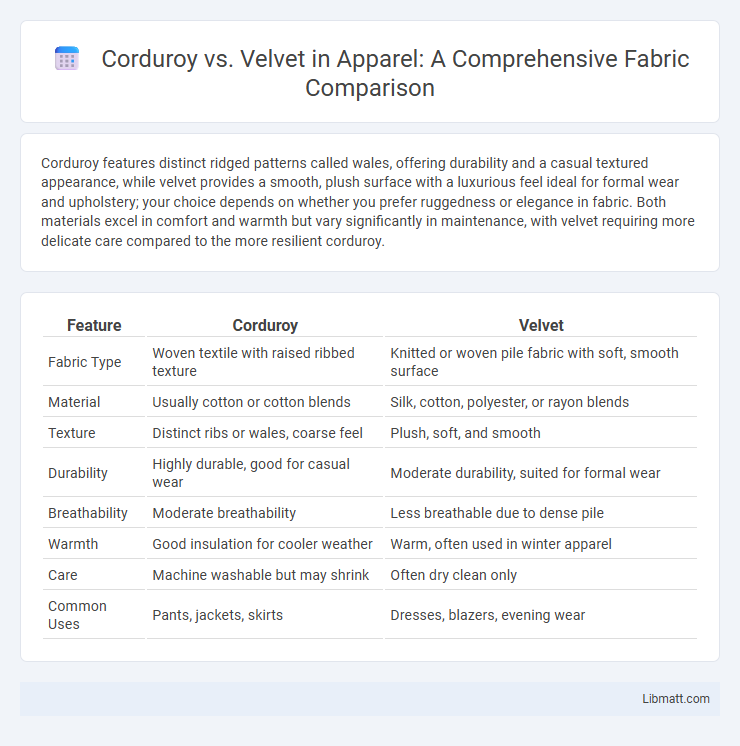Corduroy features distinct ridged patterns called wales, offering durability and a casual textured appearance, while velvet provides a smooth, plush surface with a luxurious feel ideal for formal wear and upholstery; your choice depends on whether you prefer ruggedness or elegance in fabric. Both materials excel in comfort and warmth but vary significantly in maintenance, with velvet requiring more delicate care compared to the more resilient corduroy.
Table of Comparison
| Feature | Corduroy | Velvet |
|---|---|---|
| Fabric Type | Woven textile with raised ribbed texture | Knitted or woven pile fabric with soft, smooth surface |
| Material | Usually cotton or cotton blends | Silk, cotton, polyester, or rayon blends |
| Texture | Distinct ribs or wales, coarse feel | Plush, soft, and smooth |
| Durability | Highly durable, good for casual wear | Moderate durability, suited for formal wear |
| Breathability | Moderate breathability | Less breathable due to dense pile |
| Warmth | Good insulation for cooler weather | Warm, often used in winter apparel |
| Care | Machine washable but may shrink | Often dry clean only |
| Common Uses | Pants, jackets, skirts | Dresses, blazers, evening wear |
Understanding Corduroy: Fabric Composition and History
Corduroy, a durable textile made from twisted fibers that create distinctive parallel ridges called wales, has a rich history dating back to the 18th century in England. Its fabric composition typically includes cotton or a cotton blend, which provides breathability and comfort while maintaining robustness. Understanding this fabric's unique construction helps you appreciate its longevity and why it remains a popular choice for both casual and formal wear.
Velvet Defined: Origins and Unique Features
Velvet, originating from ancient Egypt and popularized in the medieval period, is a luxurious fabric characterized by its dense, soft pile created through a weaving technique that raises cut threads evenly across the surface. Unlike corduroy, which features distinct parallel ribs or wales, velvet's smooth, plush texture results from closely packed fibers, giving it a rich sheen and a tactile, almost reflective quality. The fabric's unique pile structure and historical prestige make velvet a standout choice for elegant garments and upholstery, emphasizing opulence and depth in design.
Texture Showdown: Corduroy vs Velvet Feel
Corduroy features distinct ridged textures formed by parallel cords or wales, offering a firm and slightly coarse feel ideal for casual wear and durability. Velvet boasts a smooth, plush surface with a dense pile, providing a soft, luxurious sensation often associated with formal and elegant garments. The tactile contrast highlights corduroy's structured roughness versus velvet's silky richness, influencing choice based on comfort and style preferences.
Durability Comparison: Which Fabric Lasts Longer?
Corduroy, made from twisted fibers that create raised ridges, is known for its durability and resistance to wear, making it suitable for heavy-use garments and upholstery. Velvet, composed of dense, closely woven fibers with a soft pile, offers a luxurious texture but is more prone to crushing and abrasion over time. In terms of longevity, corduroy generally outperforms velvet due to its robust construction and ability to maintain appearance despite frequent use.
Maintenance and Care: Keeping Corduroy and Velvet Fresh
Corduroy requires regular brushing to remove dust and prevent flattening of its distinctive ribbed texture, while velvet demands gentle steaming or brushing to maintain its soft, plush pile and avoid crushing. Both fabrics benefit from spot cleaning with mild detergents, but velvet is more sensitive to water and stains, necessitating prompt and careful treatment. Your careful maintenance routine ensures corduroy and velvet garments remain vibrant and comfortable for longer wear.
Fashion Applications: Styling with Corduroy and Velvet
Corduroy's textured ridges create a rugged yet refined look ideal for casual jackets and pants, offering durability and warm tones that match autumn wardrobes. Velvet exudes luxury with its soft, glossy finish, perfect for evening wear, blazers, and statement accessories that elevate formal outfits. Your styling choices can balance corduroy's casual charm with velvet's sophisticated sheen to craft versatile looks suitable for various occasions.
Comfort Factor: Which Fabric Is More Comfortable?
Corduroy, made from twisted fibers that form distinct ridges, offers warmth and a soft, breathable texture, making it comfortable for cooler climates. Velvet, characterized by its dense pile and smooth surface, provides a luxurious, plush feel that feels soft against the skin but may retain heat. Comfort preferences depend on temperature needs, with corduroy excelling in breathability and velvet in softness.
Seasonal Suitability: Corduroy vs Velvet Through the Year
Corduroy excels in cooler months due to its thick, ribbed texture that provides warmth and durability, making it ideal for fall and winter garments. Velvet, with its smooth, rich pile, offers a luxurious feel that suits both winter and special occasion wear but can be less breathable in hot weather. Choosing between corduroy and velvet depends on your need for insulation and the seasonal context of your wardrobe.
Sustainability and Eco-Friendliness of Each Fabric
Corduroy, typically made from cotton, can be sustainable when produced using organic fibers and low-impact dyes, reducing environmental harm and promoting biodegradability. Velvet's eco-friendliness depends on its fiber origin; natural silk or organic cotton velvets offer more sustainable options compared to synthetic velvets made from polyester, which have a higher carbon footprint and are less biodegradable. Choosing eco-friendly versions of either fabric supports your commitment to sustainable fashion by minimizing chemical use and resource consumption.
Choosing the Best: When to Pick Corduroy or Velvet
Corduroy offers durability and texture ideal for casual wear and cold-weather garments, while velvet provides a luxurious, soft finish perfect for formal occasions and elegant upholstery. When choosing between corduroy and velvet, consider your need for comfort, appearance, and the garment's or item's intended use. Your choice depends on whether you prioritize practicality and ruggedness or sophistication and smoothness.
Corduroy vs velvet Infographic

 libmatt.com
libmatt.com